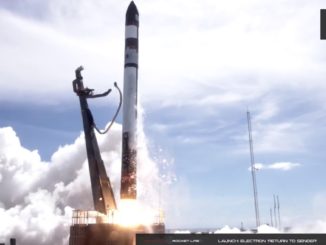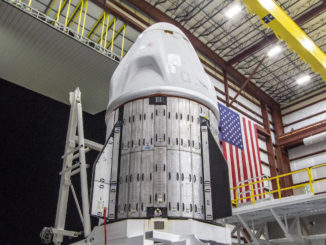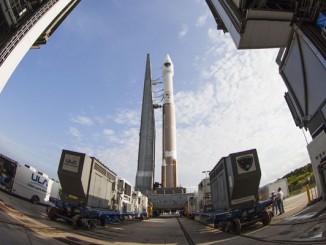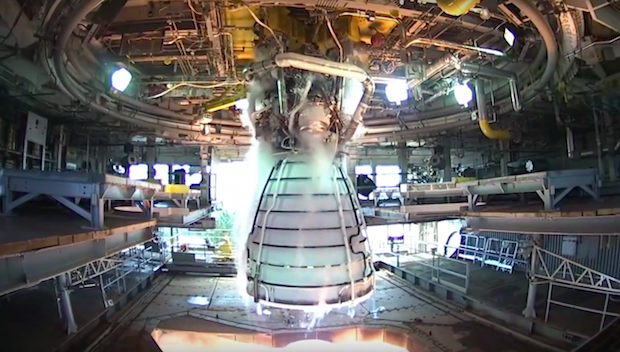
NASA and Boeing have awarded Aerojet Rocketdyne widely-anticipated contracts to restart the production of simplified shuttle-era rocket engines for the heavy-lift Space Launch System and supply the propulsion system for the CST-100 Starliner commercial crew capsule, officials announced this week.
The deals are welcome news for Aerojet Rocketdyne, which in the last year has lost an engine contract for Orbital ATK’s Antares rocket and is running second in a race with Jeff Bezos’ Blue Origin to supply engines for United Launch Alliance’s next-generation Vulcan rocket.
The Space Launch System contract announced Monday, valued at $1.16 billion, begins the process to resume production of RS-25 engines after the assembly line was shut down nearly a decade ago in the final years of the space shuttle program.
“The first phase of this contract covers the scope of work related to restarting the production lines for RS-25 plus the materials of future production efforts,” said Cheryl Warner, a NASA spokesperson. “The second phase, which will include a contract modification at a later date, is related to the labor required for the delivery of six new flight engines.”
The future modification would enable the space agency to order six engines, enough for one SLS flight with two spares. A seventh engine is included in the deal for use in ground certification testing, Glenn Mahone, an Aerojet Rocketdyne spokesperson, told Spaceflight Now.
Two other engines will be retrofitted for ground tests, Warner said.
The engines will be built at Aerojet Rocketdyne’s DeSoto plant in Chatsworth, California, with final assembly and testing at NASA’s Stennis Space Center in Mississippi.
NASA’s current inventory includes 16 RS-25 engines left over from the space shuttle program, enough for four SLS missions. The construction of six new engines enables a fifth SLS flight in the 2020s.
“SLS is America’s next generation heavy-lift system,” said Julie Van Kleeck, vice president of advanced space and launch programs at Aerojet Rocketdyne, in a press release. “This is the rocket that will enable humans to leave low Earth orbit and travel deeper into the solar system, eventually taking humans to Mars.”
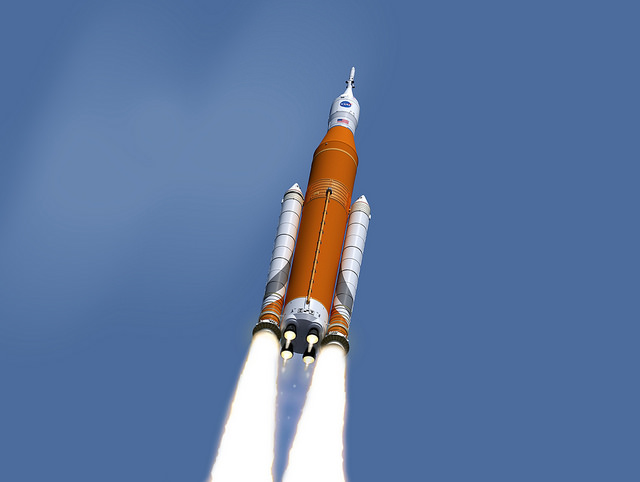
NASA previously said it was negotiating with Aerojet Rocketdyne for the sole-source RS-25 production contract.
A statement released by Aerojet Rocketdyne said the contract runs from November 2015 through Sept. 30, 2024.
Each Space Launch System flight will be powered by four RS-25 engines at the bottom of the rocket’s core stage, plus two solid rocket boosters, enlarged variants of the solid-fueled motors from the space shuttle program.
The first test flight of the Space Launch System is scheduled for 2018 — along with an unpiloted Orion crew spacecraft — flying in its 70-metric ton (77-ton) configuration with a second stage derived from United Launch Alliance’s Delta 4 rocket. A bigger upper stage, needed to carry cargo such as habitats into deep space, will debut on a later SLS flight, possibly as soon as the launcher’s second flight with a crewed Orion on-board some time between 2021 and 2023.
Originally designed in the 1970s, the RS-25 engine burns a mixture of liquid hydrogen and liquid oxygen propellants and generates up to 512,300 pounds of thrust in vacuum. In 405 engine flights through the life of the shuttle program, only one engine failed, with little impact to the mission.
In an interview with Spaceflight Now in August, Van Kleeck said Aerojet Rocketdyne targeted a 30 percent reduction in the price of an RS-25 engine in the new production contract, largely due to 3D printing, or additive manufacturing, technology.
The engines will also be simplified because they will not be reusable like the space shuttle’s engines. Because the engines will be discarded after each SLS flight, engineers plan to run them at higher thrust levels.
The engines on the first SLS test flight in 2018 will run at 109 percent of rated thrust, up from the 104 percent setting normally used on shuttle launches. Officials plan to eventually certify the engine for a 111 percent thrust level.
“On shuttle, we would light the engines, they would take off, they’d fly for eight-and-a-half minutes and they’d come back with the orbiters,” said Timothy Duquette, an SLS engines engineer at NASA’s Marshall Space Flight Center in Alabama. “For SLS, it’s not coming back. So these are now expendable engines. One of the things that allows us to do is we actually run them at slightly higher thrust than we used to, a higher power level. It’s a little harder on the engine, we’re running it a little closer to redline, but it’s safe, especially for short durations on a mission like SLS.”
Van Kleeck said Aerojet Rocketdyne will consolidate its engine production at the company’s DeSoto plant in Chatsworth, California, after shutting down a facility in nearby Canoga Park, further streamlining the factory processing.
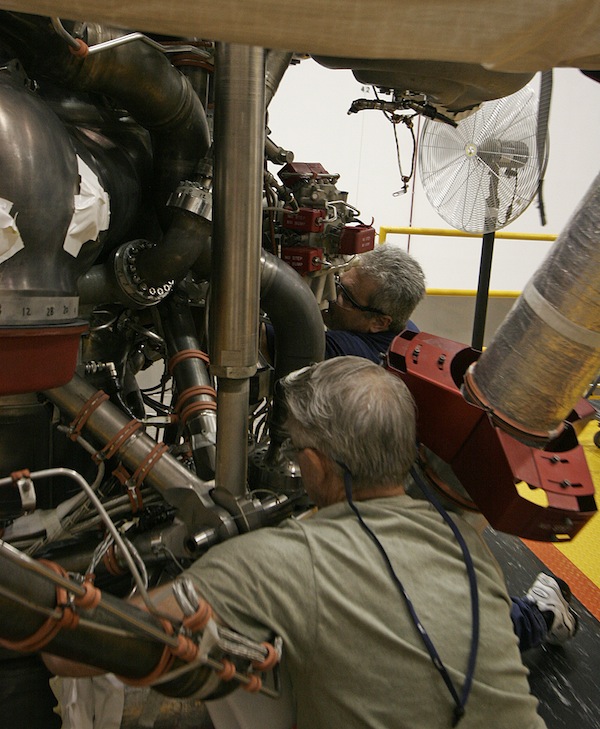
The engine design will also get a review to identify obsolete components.
“Obsolescence is an issue we deal with in rockets all the time because you deal with low volumes, and so we’ve got pretty good processes for monitoring that, as well as trying to do risk management for that purpose,” Van Kleeck told Spaceflight Now in August, when NASA and Aerojet Rocketdyne were in negotiations for the new RS-25 contract.
Engineers are already testing a modernized computer controller — developed by Aerojet Rocketdyne and Honeywell — for the engine. It will be introduced on the first SLS flight.
“For example, the controller was essentially obsolete,” Van Kleeck said. “We built a new controller — a brand new design — because electronics and computers have really evolved quite a lot in the last few decades.
“We’ll go through the entire engine, and part of restarting the build is to make sure that we’ve dealt with any obsolescence if we have any,” Van Kleeck said. “If the last supplier went out of business, what do we do about that?”
She said the new flight-ready RS-25 engines are targeted for delivery to NASA in 2022 or 2023.
The engine cost-cutting initiative is vital to NASA’s goal of flying the Space Launch System once per year after the first crewed mission in the early 2020s, an objective that Bill Hill, head of the agency’s exploration systems programs, said in August requires the rocket to cost less than a billion dollars per flight.
Managing the launch costs will also help NASA afford habitation modules and other advanced systems needed for long-duration human expeditions into deep space, all aimed at paving the way for astronaut trips to the vicinity of Mars, a mission NASA says is possible in the 2030s.
“Not only will ($1 billion launch costs) get us to one per year, but if we have a flat-line $3 billion budget and it costs me a billion dollars for SLS, and say half a billion dollars for Orion … then I’ve got some head room to go do other things like buy a habitat and other things that we’re going to need to operate in space for the long-term.”
So how is the SLS team doing on cost?
“We’re a good ways away,” Hill told Spaceflight Now in August. “I got my first report in our budget cycle this year, and it was a lot higher than I expected. Orion was a little bit better, so I think we’ve got work to do … We’ve got to get our cost of our engines down and that’s part of this, and part of what Aerojet Rocketdyne is doing with their new plant in DeSoto, just to get it to a point where we can afford to fly this thing on a yearly basis.”
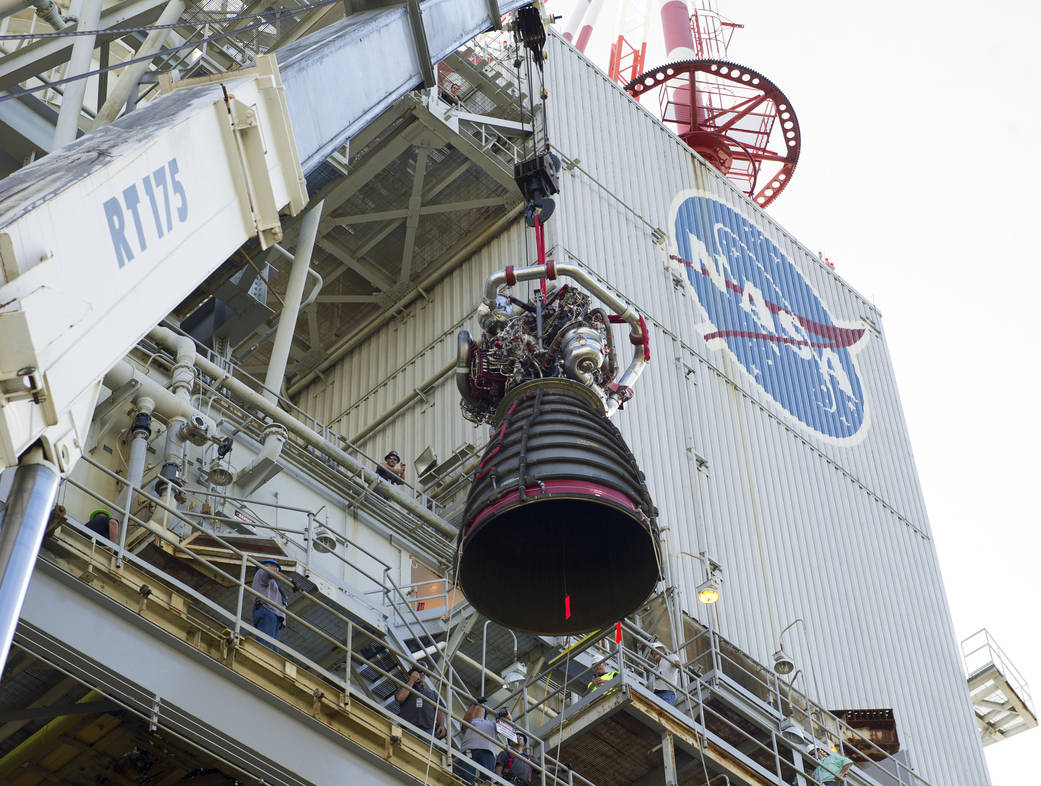
The unit cost for each new RS-25 engine under the contract announced this week has not been disclosed, but Hill said NASA hopes to reduce its cost to $50 million or $60 million per engine.
“That still is a lot of money when you consider you’re using four of those per mission,” Hill said. “We’re looking at affordability initiatives with Aerojet Rocketdyne. It’s trying to get them to take a look at their processes, how they actually build the engine, can you use selective laser melting on certain parts? The whole selective laser melting will revolutionize manufacturing, especially in our industry, and if we can get those things down where you can machine a critical part — a complex part — where it might have taken you six-to-eight months, and you can do it in maybe two or three, that’s very helpful.”
Despite the cost and complexity, NASA officials said the existing stockpile of RS-25 engines, along with its high performance, made the shuttle-era propulsion system an obvious choice for the Space Launch System.
“It’s the best technical solution, by far, for SLS propulsion,” said Steve Wofford, manager of the SLS liquid engines office at Marshall. “It’s also the most affordable solution for this vehicle.
“In addition to those 16 engines (in inventory), it’s also a stable design, so the cost and time associated with going through the design, fail, fix cycles to develop a new engine are enormous,” Wofford said.
Company also gets nod for CST-100 propulsion system
Aerojet Rocketdyne, an aerospace propulsion contractor based in Sacramento, California, also announced this week it secured an expected contract from Boeing to provide thrusters, fuel tanks and abort engines for the CST-100 Starliner commercial crew capsule.
The CST-100 contract is worth nearly $200 million, Aerojet Rocketdyne said in a statement, and it covers seven “shipsets,” or complete propulsion kits, for the crew capsule’s service module.
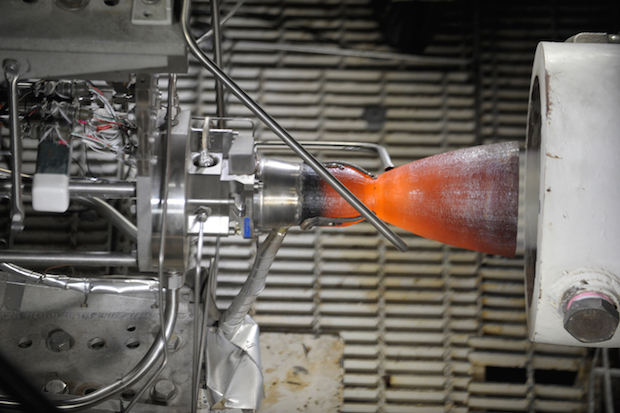
Each shipset includes four 40,000-pound thrust launch abort engines for the CST-100’s pusher escape system and 24 orbital maneuvering and attitude control thrusters, each generating 1,500 pounds of thrust for low-altitude abort attitude control and in-space orbit adjustments.
Each propulsion kit also has 28 reaction control system engines for high-altitude abort attitude control, smaller burns in orbit, and space station re-boost capability. The shipsets also include 164 valves, 12 tanks and more than 500 feet of ducts, lines and tubing for the service module propulsion system, Aerojet Rocketdyne said.
Boeing plans to reuse the CST-100 crew module, but the service module will be jettisoned to burn up in Earth’s atmosphere on re-entry. Smaller Aerojet Rocketdyne thrusters will guide the crew capsule through the atmosphere before parachutes and airbags deploy for touchdown on land.
The crew and service modules are constructed by Boeing engineers at the Commercial Crew and Cargo Processing Facility, a refurbished space shuttle hangar, at NASA’s Kennedy Space Center in Florida.
The first CST-100 test flights, first without a crew and then with astronauts, are scheduled for 2017. A standard operational crew rotation mission to the International Space Station will carry four astronauts and a limited amount of cargo.
NASA selected Boeing and SpaceX last year to complete development of new commercially-owned spaceships to end U.S. reliance on Russia’s Soyuz spacecraft to ferry astronauts to and from the space station.
“Aerojet Rocketdyne is leveraging adaptations of proven hardware and technologies to deliver an affordable reliable propulsion system that can be counted on to perform throughout the spacecraft’s mission and ensure the safety of the astronauts and success of the mission,” said Terry Lorier, Aerojet Rocketdyne’s CST-100 service module propulsion system program manager. “We are honored to play a critical role in continuing our nation’s legacy in human-rated spaceflight, as well as helping to revolutionize how our great country accesses and explores space.”
Email the author.
Follow Stephen Clark on Twitter: @StephenClark1.

